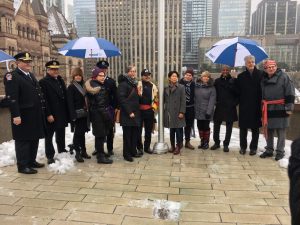Video by Santiago Ramer
Story by Mariam Baher

The Métis community came together for Louis Riel Day at this morning’s flag raising ceremony at Toronto City Hall.
“For a long time, I equated to being a ghost. I felt invisible,” says Selina Young, manager of the Indigenous Affairs Office for the City of Toronto.
Cultural Awareness
Although there are many laws in place to help Indigenous people prosper in Canada, they continue to face discrimination and inequality. Unlike equality which is coded within Canadian law, equity is not.
“There’s Indigenous awareness,” Selina Young said, “Indigenous cultural safety training that happens in the city so people understand the horrible things that happened in the past, how that got us here and what we can do together in the Toronto Public Service moving forward.”
Alicia Blore, who was also present for the Louis Riel Day ceremony, is an education officer at the Métis Nation of Ontario.
“There’s a lot to be done on education, (there are) a lot of misconceptions on who Métis people are,” said Blore, “we try to focus on educating our Métis people, youth, on what our history is, what our culture is, traditions just to help those Métis youth with identity struggle.”
Education
The Canadian Human Rights Commission conducted a report on the “Equality rights of Aboriginal people.” The report concluded that proportionally fewer Aboriginal adults report that their job is ‘‘closely related’’ to their specialization when compared to non-Aboriginal adults.
According to the report, many Indigenous adults report having access to education that is relevant to their culture. The report states, “A high proportion of Aboriginal women and men report being taught about Aboriginal peoples.”
Loss of Identity
Megan Southwell, a third year socio-cultural anthropology and Indigenous studies student at the University of Toronto and a member of the Métis Nation of Ontario said that she feels discriminated by the way she looks, Caucasian.
“I’m really fair, I have really white skin so people don’t often take me seriously when I say that I’m Métis,” Southwell said, “I actually do have native blood but people don’t see beyond the skin colour and beyond my eye colour a lot of times.”
Blore agrees with Southwell, she also feels like an “invisible minority” and said she never knew where to fit in while growing up. Blore said identity is one of the major struggles Métis people have.
Infographic by Mia Maaytah
Web design/Social media by Vanessa Rogers

Leave a Reply